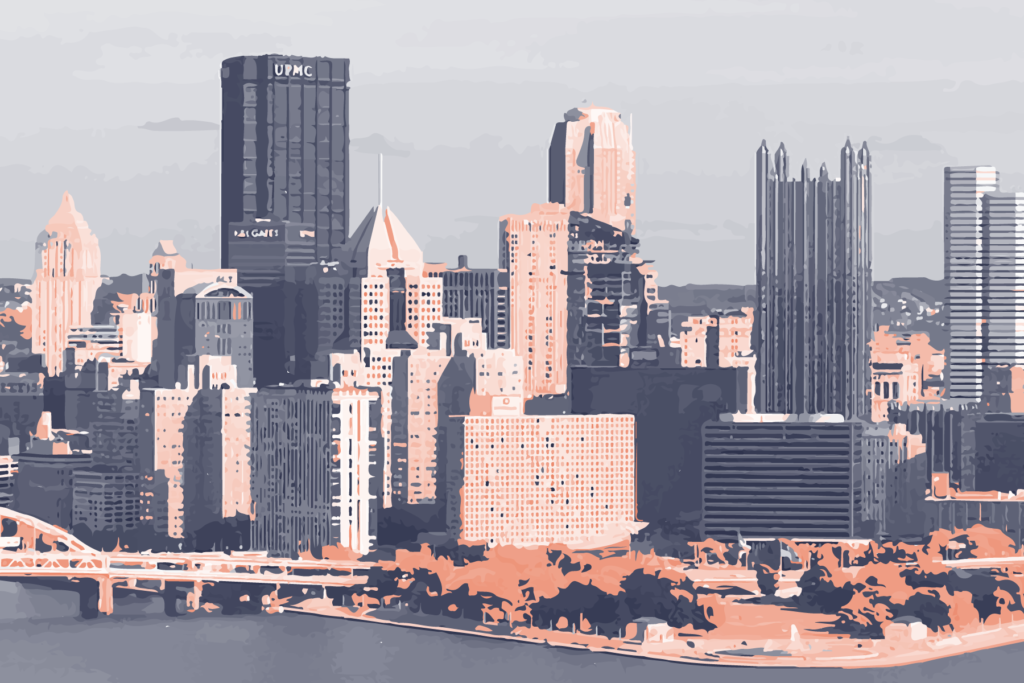 High above the Pittsburgh skyline, the gleaming 64-story skyscraper once known as US Steel Tower today bears very different insignia. In bold white capitals, some 250 metres above street level, the initials UPMC – University of Pittsburgh Medical Centre – testify to the seismic economic shift that’s fast changing Pittsburgh’s fortunes.
High above the Pittsburgh skyline, the gleaming 64-story skyscraper once known as US Steel Tower today bears very different insignia. In bold white capitals, some 250 metres above street level, the initials UPMC – University of Pittsburgh Medical Centre – testify to the seismic economic shift that’s fast changing Pittsburgh’s fortunes.
Following the collapse of the steel industry in the 1990s, the city in which Hillman, Heinz and Carnegie made their fortunes switched focus from primary metals to education and medicine (‘eds and meds’). Today, despite being located deep in the heart of the so-called Rust Belt, a newly resurgent Pittsburgh is being hailed as a tech hub of global note.
Google, Apple, Uber, Intel, General Motors: some of the world’s leading tech firms now call this former metal town ‘home’, and for good reason. Pittsburgh’s combination of philanthropic tradition, emphasis on education and research, and creative public-private partnerships is propelling the city into the 21st century at a rate that’s outpacing many traditional knowledge centres in the US. But how?
From rust belt to brain belt
In Pittsburgh, several factors – visionary thinkers, local universities, regional government initiatives, start-ups, and big corporations – combined forces to transform the city from ailing metropolis into part of the emerging ‘brain belt’. “What Pittsburgh has – and what Silicon Valley doesn’t, and what Boston doesn’t have as good as us – is that we have the ability to create world-class research to become a global innovation centre for corporations around the world,” Mayor William Peduto told Time magazine (Pittsburgh: The Comeback | TIME).
 Key to nurturing that world-class research is Pittsburgh’s ability to attract the necessary talent. As pointed out by Alan Berube and Natalie Holmes of the Brookings Institution, “human capital – often measured as the rate of higher educational attainment among the adult population – is among the most important contributors to growth in those advanced economies that specialize in knowledge-based industries”.
Key to nurturing that world-class research is Pittsburgh’s ability to attract the necessary talent. As pointed out by Alan Berube and Natalie Holmes of the Brookings Institution, “human capital – often measured as the rate of higher educational attainment among the adult population – is among the most important contributors to growth in those advanced economies that specialize in knowledge-based industries”.
At the turn of the millennium, following years of decline, Pittsburgh’s population was in the grip of a brain drain. “Specifically, the people who were leaving were the young, 20-something, professional and educated workers who we really needed to transform and move our economy forward,” writes Chris Briem, chair of Pitt’s Center for Social and Urban Research.
Between 2000 and 2012, however, the number of college graduates in Pittsburgh between the ages of 25 and 34 grew by 29% – lured by the inherent promise of this Maker City. As Harvard economist Edward Glaeser notes in Triumph of the City: “There is a very strong track record of places that attract talent becoming places of long-term success. The most successful economic development policy is to attract and retain smart people and then get out of their way.”
Reimagining education
Much of Pittsburgh’s strength is derived from its solid foundation of networked groups, among them museums, community-based organizations, makerspaces, schools and universities. This Maker City ecosystem – now one of the most extensive and collaborative in the world – first began to evolve organically when it became apparent that Pittsburgh’s education system was failing the city’s children.
Gregg Behr, executive director of the Grable Foundation, was new to the job when he first discovered the disconnect between education stakeholders and students. “That presented the question: is there something seismic that’s happening among youth and youth culture, in a way that should prompt us to think differently about how we’re supporting schools, museums, libraries, and then the construction, the exhibit and the design of camps, as well as the professional development to support all of these types of institutions that could or should be relevant to kids’ lives?”
What followed, beginning with a pancake-breakfast brainstorm, was the bringing together of more than 250 organizations in what is now known as the Remake Learning Network: “highly coordinated communities of people and organizations allowing for synergies, swapping ideas, rubbing shoulders, and working together toward a shared vision”, a model being adopted by Maker cities across the US.
This education-centric innovation cluster started simply enough: a single Makerspace was established in a single school, giving kids access to modern production tools as a way to excite involvement. From this evolved the Dream Factory at Elizabeth Forward Middle School: a state-of-the-art Maker lab for students across southern Pittsburgh.
The Dream Factory is a set of integrated classrooms where kids learn how to use computers, 3D printers and CNC tools – sharpening their science, technology, engineering and mathematics (STEM) skills – to create robots, drones or anything else that takes their fancy. The result? School drop-out rates have fallen drastically.
Other institutions are following suit: community colleges are now aligning courses with emerging job clusters and the needs of employers. One example, the Westmoreland County Community College, now boasts an entire facility dedicated to advanced technology.
Pittsburgh: it’s nicer than you think
Retaining a ‘creative class’ of people with the necessary skills to rejuvenate an economy, however, takes more than just cutting-edge classrooms. And Pittsburgh, which is part of the regional indicators project, has consistently ranked at or near the top of the 16 areas involved in many key quality of life indices.
As Chester R Babst III, managing shareholder of Babst Calland, notes in the 2017 Pittsburgh Today and Tomorrow report: “Our region has become a center of innovation, energy, education, culture and livability across many fronts. With Pittsburgh ranked so frequently in recent years in national and global benchmarks, we should continue to make strides in our ability to attract a more diverse workforce.”
According to this year’s report, one of the main factors contributing to Pittsburg’s livabiity is the region’s relative safety, with crime rates among the lowest in the US. ‘Crime overall fell again throughout the seven-county Pittsburgh Metropolitan Statistical Area in 2015, dropping 2.7 percent, according to the most recent FBI Uniform Crime Reports data,’ the report states. The report’s authors attribute the low crime levels to several local characteristics, including Pittsburgh’s relatively stable economy and less-transient population (90% of residents have been living in the region for longer than 10 years).
Alternative transport is another plus: southwestern Pennsylvania’s largest public transit system has recently improved its financial standing, heralding the addition of bike lanes along city streets, which in turn enables more people to live in the urban core. US Census Bureau data suggest that more than 11% of Pittsburgh commuters walk and 1.5% travel by bicycle (only Boston, Washington, DC, and San Francisco have higher rates). According to Seattle-based company Walk Score, Pittsburgh is the 25th most walkable of the 141 US and Canadian cities it ranks.
Affordable housing is also among Pittsburg’s positive indices: the region has largely been spared the drama of skyrocketing prices and bursting housing bubbles, with its rate of home ownership among the nation’s highest: more than 69 percent of Pittsburgh Metropolitan Statistical Area residents own their home.
Monthly rental prices are more affordable, too. According to Zumper’s most recent national report, median rent in Pittsburgh is dropping. This month, one-bedroom prices sank to $1,040, marking a 4.6% decrease over the previous month. Meanwhile, in San Francisco, a one-bedroom apartment costs an average of $3,330.
The digital divide is closing, too. “In Pittsburgh, it’s not so much that people have a hard time accessing hardware—smart phone or a smart device,” says Debra Lam, the City of Pittsburgh’s chief innovation and performance officer. “The bigger issue is that once you have that smart device, what do you use to connect it?” In 2015, the city launched the Roadmap for Inclusive Innovation, a plan to improve access to the Internet and technology, which includes expanding public Wi-Fi access in parks, senior centers and other public areas.
Dr Arthur Levine is dean of the University of Pittsburgh Medical Centre, which – with 60,000 employees – is the largest private employer in western Pennsylvania. “This is a small American city, but we have one of the country’s leading symphony orchestras, ballet, theatre, terrific restaurants, lots of bicycle lanes,” he told Time magazine. “This is a city that captures the sophistication of the East Coast and retains the civility of the mid-West.”

